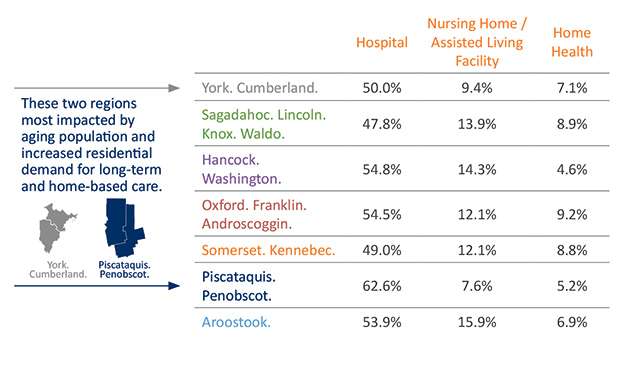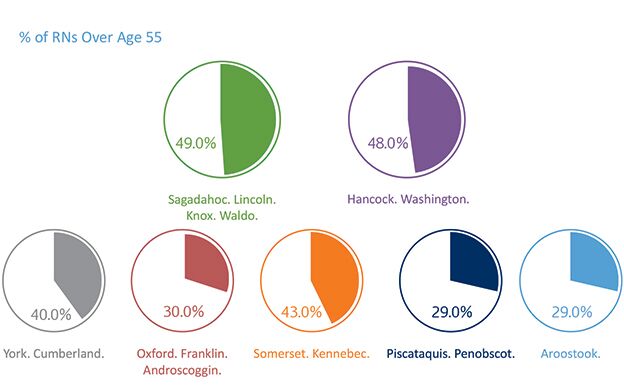
Coalition: Nearly half of Midcoast, Downeast nurses to retire in next decade
 Courtesy / Maine Nursing Action Coalition
A new report released Thursday highlights how Maine's aging nursing workforce will impact different regions of the state within the next decade. The report includes a call to action to increase the number of new registered nurses entering Maine's workforce.
Courtesy / Maine Nursing Action Coalition
A new report released Thursday highlights how Maine's aging nursing workforce will impact different regions of the state within the next decade. The report includes a call to action to increase the number of new registered nurses entering Maine's workforce.
Nearly half the registered nurses working in Midcoast and Downeast Maine are expected to retire or reduce work hours over the next 10 years, according to new report released Thursday by the Maine Nursing Action Coalition.
The report, which updates the 2016 Maine Nursing Forecaster released in January, also shows that southern Maine and the Penobscot and Piscataquis regions will be most challenged by aging populations and increased demand for residential long-term and home-based health care in the next decade.
Data and projections in the new analysis shows that Maine faces a shortage of RNs that is expected to grow to 3,200 by 2025.
Maine Nursing Action Coalition released the data at a joint meeting of OMNE/Nursing Leaders of Maine and ANA-Maine as leaders in health care, education and public policy prepare for a statewide summit hosted by the University of Maine System and the Maine Department of Health and Human Services focused on increasing Maine’s supply of nursing professionals.
The updated analysis and recommendations will inform the Oct. 27 Nursing Summit at the University of Maine.
Key findings from the updated data include:
- Coastal Maine faces a wave of retirements: Nearly half of the RNs in the Sagadahoc, Lincoln, Knox and Waldo counties region (49%) and the Hancock and Washington counties region (48%) are over the age of 55 and are expected to retire or reduce hours in the next 10 years. The wave approaching retirement is smaller in percentage terms in York and Cumberland counties (40%) but Maine’s southern coastal counties account for 39% of the state’s nursing workforce.
- Challenge in meeting growing demand for long-term or home-based care: Maine’s aging population and an increasing demand for non-acute care will create challenges for residential facilities and home-based care providers across Maine. The York and Cumberland counties region (9.4%) and the Penobscot and Piscataquis counties region (7.6%) have the smallest percentages of their existing nursing workforce in nursing homes or assisted living facilities and will be especially challenged in meeting demand.
- Proportion of residents over 65 to grow: Demand for health care services, expected retirements among nursing professionals and the resulting nursing workforce shortage are directly related to Maine’s aging population. Nearly a third of the residents in Midcoast and Downeast Maine will be above the age of 65 by the year 2022 and every region of the state except for Aroostook County will see a double-digit percentage increase in the size of its senior population.
A call to action

To prevent the shortage of 3,200 nursing professionals projected by 2025, Maine must increase the number of new RNs licensed in the state by 400 annually, a 65% increase over current capacity, MeNAC reported.
To avoid the projected “nursing workforce cliff,” the report stated that Maine must also attract or recruit an additional 265 RNs to the state each year.
“The surge in demand for health care and an increasing number of retirements in the nursing workforce are not unique to Maine,” said Lisa Anderson, senior vice president with the Center for Health Affairs Northeast Ohio Nursing Initiative, the organization that developed the 2016 Maine Nursing Forecaster. “But in a national perspective the nursing workforce shortage in Maine is particularly acute because of the state’s aging population and the logistical challenge of delivering care to rural and remote communities.”
“It is with an abundance of concern for our state and the patients in our care that we continue to sound the alarm about Maine’s nursing workforce cliff.” said Lisa Harvey-McPherson, a registered nurse and co-chair of the MeNAC. “Every region of Maine and every health care setting faces challenge as our state ages and a wave of dedicated caregivers approaches retirement. It is going to take resources, resilience and partnership to meet Maine’s need for health care services.”
Ricker Hamilton, acting commissioner of the Maine Department of Health and Human Services, agreed.
“If we are going to address the challenges facing the nursing workforce across our state, it is imperative that we do so collaboratively,” Hamilton said. “Next month’s Maine Nursing Summit offers us all a unique opportunity to discuss these issues and develop solid recommendations on how to combat this impending nursing shortage.”
DOWNLOAD PDFs
Maine Nursing Action Coalition's infographic on shortage of registered nurses










Comments